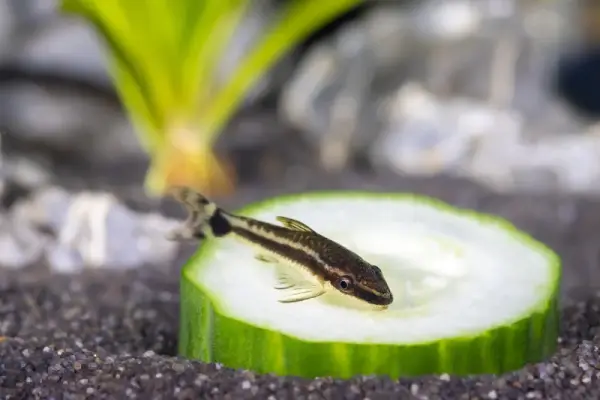Otocinclus, also known as oto cats, dwarf suckermouths, or algae eaters, are small and peaceful fish that can make a great addition to any freshwater aquarium. They are especially useful for keeping algae under control, as they love to graze on the surfaces of plants, rocks, and glass. However, otocinclus are not the easiest fish to care for, and they require some special attention and conditions to thrive. In this blog post, we will cover everything you need to know about Otocinclus, including their care, lifespan, food, and breeding. By the end of this post, you will be able to decide if Otocinclus are the right fish for you and how to provide them with the best possible environment.
What are otocinclus?
Otocinclus is a genus of small catfish that belongs to the family Loricariidae, which includes over 800 species of armored catfish. Otocinclus are native to South America, where they inhabit streams and rivers with clear, fast-flowing water. They are usually found in large groups, and they use their sucker-like mouths to attach themselves to various surfaces and feed on algae and biofilm. Otocinclus are very sensitive to water quality and parameters, and they need a well-established and stable aquarium to survive. They are also very shy and timid, and they prefer to hide among plants and driftwood. Otocinclus are compatible with most other peaceful and small fish, such as tetras, rasboras, guppies, and danios. However, they should not be kept with larger or aggressive fish, such as cichlids, barbs, or goldfish, as they may harass or eat them.

How to Care for Otocinclus
Otocinclus are not recommended for beginners, as they have some specific requirements and can be easily stressed or killed by poor water conditions. Here are some of the main factors that you need to consider when caring for Otocinclus:
Tank size and setup
Otocinclus are social fish, and they should be kept in groups of at least 6 to 10 individuals. A single Otocinclus can reach up to 2 inches in length, requiring a minimum 10-gallon tank for a small group. However, larger tanks are better to accommodate their active nature. Provide plenty of hiding spots like plants, rocks, and caves for security. Use soft substrate like sand or gravel to prevent mouth injuries. Avoid sharp or rough decorations to protect their skin.

Water quality and parameters
Otocinclus are very sensitive to water quality and parameters, and they need clean and well-oxygenated water to thrive. Perform regular water changes (25%-50% weekly) to remove waste and toxins. Use a good filtration system to keep water clear and monitor parameters regularly. The ideal water parameters for Otocinclus are:
water parameters for Otocinclus
| Requirement | Describe |
| Temperature | 72°F to 79°F (22°C to 26°C) |
| pH | 6.5 to 7.5 |
| Hardness | 6 to 15 dGH |
| Ammonia | 0 ppm |
| Nitrite | 0 ppm |
| Nitrate | less than 20 ppm |
You should also avoid any sudden or drastic changes in the water parameters, as they can cause stress or shock to the Otocinclus. If you need to adjust the water parameters, do it gradually and carefully, using products such as water conditioners, buffers, or heaters.
Food and diet
Otocinclus are primarily herbivorous, and they feed on algae and biofilm that grow on the surfaces of the tank.
While algae and biofilm are essential for Otocinclus, supplement their diet with high-quality plant-based foods like algae wafers, spirulina flakes, and blanched vegetables. Occasionally offer treats like bloodworms and brine shrimp. Feed once or twice daily, only what they can consume in a few minutes. You should also remove any uneaten food from the tank to prevent it from rotting and polluting the water.

How long does Otocinclus live?
Otocinclus has a relatively short lifespan compared to other catfish. The average lifespan of Otocinclus is 3 to 5 years, varying based on genetics, health, and care. They are susceptible to diseases like ich and fungus, preventable with good water quality and medication. Provide a balanced diet and stress-free environment to extend their lifespan.
How to Breed Otocinclus
Otocinclus are not easy to breed in captivity, requiring specific conditions and triggers. They are egg-layers, spawning in groups after heavy rain or a large water change. The male chases the female to release eggs, which he fertilizes. Eggs are adhesive, sticking to surfaces and hatching in 3 to 4 days. Fry are tiny and need infusoria, microworms, or baby brine shrimp. They are vulnerable to predators, including parents and tankmates, so separating them in a breeding tank or net breeder can increase survival chances.
Conclusion
Otocinclus are beneficial algae-eating fish for freshwater aquariums, requiring special care. Beginners or those seeking low-maintenance fish should consider other options, but with proper care, they can thrive.
FAQs
Yes, Otocinclus cleans glass by grazing on algae, helping to keep the aquarium glass and other surfaces clean and clear.
Yes, Otocinclus may nibble on soft, delicate plants, but they primarily feed on algae and require a plant-based diet in captivity.
Otocinclus needs a tank size of at least 20 gallons (75 liters) with plenty of hiding spots, plants, and clean, well-oxygenated water.
Yes, Otocinclus, like all fish, needs oxygen to survive. They absorb oxygen from the water through their gills.
Otocinclus are peaceful fish and can live with other peaceful community fish that are not aggressive or too large. Suitable tankmates include small tetras, rasboras, gouramis, and dwarf cichlids.